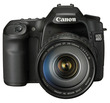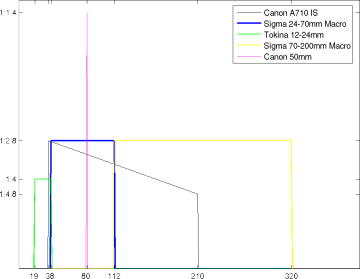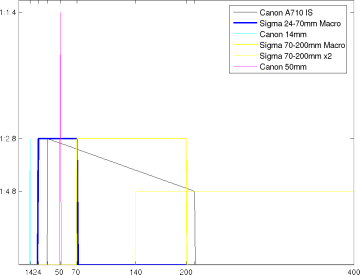Monday, September 3. 2007
Ultimate lens considerations, II

I thought a little more about what my first lenses could be, and I got inspired by one photographer’s gallery on the web. He shows many pictures living from narrow depths of field and low f-stops e.g. at f/2.8. He even shows some portraits taken with a 50mm f/1.4 lens at low light or showing awesome narrow depths of field. Therefore I noticed that having a faster lens is more important than high focal lengths, and a DSLR camera body can be used for several years without leering towards FF sensors, what that photographer showed by using an EOS 20D. After some searching I found a different scenario of lenses while coming to lower prices due to the preference of Sigma to Canon. Btw, I found out that the teleconverters can only be used for tele lenses.
 Previously I was considering the Canon EF 24-105mm f/4L IS USM [Review] as first lens. Compared to the miniature film equivalence of my PowerShot, what is @35-210mm with f/2.8-4.8, that lens covers @38-168mm and almost reaches the upper limit of @210mm. However, it only has an aperture of f/4. Sure, the IS allows longer exposures, but low f-stops and therefore very narrow depths of field aren’t possible. In addition, it’s rather expensive with €999. Luckily I found an interesting alternative, what I will mention below.
Previously I was considering the Canon EF 24-105mm f/4L IS USM [Review] as first lens. Compared to the miniature film equivalence of my PowerShot, what is @35-210mm with f/2.8-4.8, that lens covers @38-168mm and almost reaches the upper limit of @210mm. However, it only has an aperture of f/4. Sure, the IS allows longer exposures, but low f-stops and therefore very narrow depths of field aren’t possible. In addition, it’s rather expensive with €999. Luckily I found an interesting alternative, what I will mention below.
 The Tokina 12-24mm f/4 AT-X PRO DX [Review] has no ultrasonic autofocus motor, but it’s simply a good wide angle lens, and a constant value of f/4 is not so self-evident. The low @19mm are really useable. This will be my second lens for sure, and its upper focal length of @38mm should perfectly end at the beginning of the next higher lens. The €549 are quite a bit much at my preferred dealer, I could get it for €485 where I intend to buy the batteries, but I’ll often use the wide angle range, justifying the purchase.
The Tokina 12-24mm f/4 AT-X PRO DX [Review] has no ultrasonic autofocus motor, but it’s simply a good wide angle lens, and a constant value of f/4 is not so self-evident. The low @19mm are really useable. This will be my second lens for sure, and its upper focal length of @38mm should perfectly end at the beginning of the next higher lens. The €549 are quite a bit much at my preferred dealer, I could get it for €485 where I intend to buy the batteries, but I’ll often use the wide angle range, justifying the purchase.
 I finally found a very reasonable tele lens: The Sigma 70-200mm f/2.8 EX DG APO HSM IF Macro [Review] costs only half as much as the equivalent model by Canon, namely €979, what is very reasonable. Sure, it doesn’t have Sigma’s Optical Stabilizer, but a constant f/2.8 is very high, and it even has a macro function (though only with a magnification of 1:3.5). Unfortunately, it got no recommendation in ColorFoto 09/2007 for use on the EOS 20D, but just because the expensive Canon lens provided better values. But it did get a recommendation for the Nikon D200, and other users say that it can compete with the Canon. With that lens I can do good portraits at the lower @112mm at f/2.8, and still have f/2.8 at the upper @320mm, what is quite high. And did I mention it has a macro function?
I finally found a very reasonable tele lens: The Sigma 70-200mm f/2.8 EX DG APO HSM IF Macro [Review] costs only half as much as the equivalent model by Canon, namely €979, what is very reasonable. Sure, it doesn’t have Sigma’s Optical Stabilizer, but a constant f/2.8 is very high, and it even has a macro function (though only with a magnification of 1:3.5). Unfortunately, it got no recommendation in ColorFoto 09/2007 for use on the EOS 20D, but just because the expensive Canon lens provided better values. But it did get a recommendation for the Nikon D200, and other users say that it can compete with the Canon. With that lens I can do good portraits at the lower @112mm at f/2.8, and still have f/2.8 at the upper @320mm, what is quite high. And did I mention it has a macro function?
 And because I was so inspired by pictures using low f-stops, I consider the Canon EF 50mm f/1.4 USM [Review] as a possible future lens for high quality portraits. This will enable good pictures at low light, and good portraits with incredible narrow depth of field. And all this for only €369, what is really not the price range of fast zoom lenses.
And because I was so inspired by pictures using low f-stops, I consider the Canon EF 50mm f/1.4 USM [Review] as a possible future lens for high quality portraits. This will enable good pictures at low light, and good portraits with incredible narrow depth of field. And all this for only €369, what is really not the price range of fast zoom lenses.
Now I could draw the following picture of focal length coverage and aperture values of the mentioned lenses (on an APS-C sensor with crop 1.6):
The black line is my PowerShot reference, and Canon’s 24-105mm lens (red) almost covers its focal length range, but only at f/4. The green line is the Tokina 12-24mm covering the wide angles below the PowerShot. But as soon as I possess Sigma’s fast 70-200mm lens (yellow), it beats almost half the focal length range of the Canon lens. For the upper range I’ll hardly want to use the Canon at f/4 if I can have it for f/2.8 with the Sigma. If I didn’t intend to buy Canon’s 50mm f/1.4 lens (magenta), I’d have a rather flat coverage of the important medium range of @38-112mm.
 Luckily, I found a reasonable alternative. Sigma’s 24-70mm f/2.8 EX DG APO Macro seems to perfectly cover the desired initial focal length range while only costing €429. Sure, it doesn’t have an Optical Stabilizer, but it has f/2.8 instead of just f/4. And it doesn’t overlap with the range of the 70-200mm lens. Additionally, it is a macro lens (though only with 1:3.8 magnification), making it a desirable choice. Unfortunately, it doesn’t have an HSM and no IF, but that’s understandable for that price. And I haven’t found professional tests yet.
Luckily, I found a reasonable alternative. Sigma’s 24-70mm f/2.8 EX DG APO Macro seems to perfectly cover the desired initial focal length range while only costing €429. Sure, it doesn’t have an Optical Stabilizer, but it has f/2.8 instead of just f/4. And it doesn’t overlap with the range of the 70-200mm lens. Additionally, it is a macro lens (though only with 1:3.8 magnification), making it a desirable choice. Unfortunately, it doesn’t have an HSM and no IF, but that’s understandable for that price. And I haven’t found professional tests yet.
Exchanging Canon’s 24-105mm with that Sigma lens, the picture of the focal length coverage becomes this:
Now the coverage perfectly outranges the PowerShot, and the standard lens (blue) gets its justification for being there. Sure, it’s not of such a professional build, but the 50mm f/1.4 lens is perfectly positioned to compensate that.
Although I’m not so interested in considering the FF case anymore, the picture could look like that:
The Tokina 12-24mm can’t be used anymore, and its previous @19-38mm would now be partly covered by the Sigma 24-70mm anyway. Maybe I’ll think of using a fast dedicated wide angle lens, like the Canon EF 14mm f/2.8L USM. The ranges of both Sigma lenses get pushed towards lower focal lengths, and the previous upper limit of @320mm now shrinks to 200mm. But because the tele lens is fast with f/2.8, Sigma’s 2× converter makes 400mm possible while retaining the autofocus at f/5.6. And because the 24-70mm lens was so cheap, I’ll have no problem with adding a more professional lens for that range.
So, in the first time there’ll be the Sigma 24-70mm plus the Tokina 12-24mm at €914, what is below the price for the single Canon 24-105mm. Including the camera, I’d come to ~€2,200. Plus batteries, CF cards and camera bag make ~€2,500. Adding the tele lens plus teleconverter plus tripod raises this up to ~€3,800, but that might be about half a year later. The 50mm lens finally rounds up to ~€4,200. Phew! But that covers a wide time range anyway. Others buy a plasma TV. I have no car and no DVD player.
About
Calendar
| Mon | Tue | Wed | Thu | Fri | Sat | Sun |
|---|---|---|---|---|---|---|
| ← Back | January '26 | |||||
| 1 | 2 | 3 | 4 | |||
| 5 | 6 | 7 | 8 | 9 | 10 | 11 |
| 12 | 13 | 14 | 15 | 16 | 17 | 18 |
| 19 | 20 | 21 | 22 | 23 | 24 | 25 |
| 26 | 27 | 28 | 29 | 30 | 31 | |


